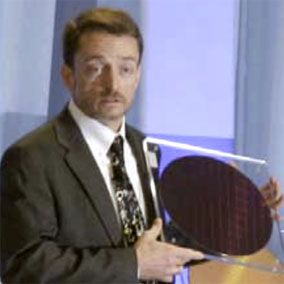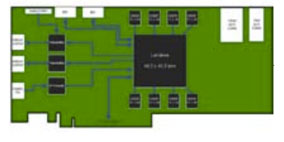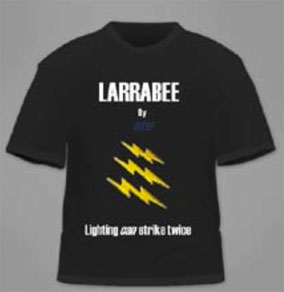
Pat Gelsinger doing his Vanna White thing with a Larrabee wafer at Beijing IDF.
(Courtesy Hardware Fr)


According to reports from those who attended the Beijing IDF conference last week, the esteemed and always amusing Senior Vice President and General Manager of the Digital Enterprise Group of Intel, Pat Gelsinger, showed a 300mm wafer he said was the first gaggle of test chips of Larrabee.
A side note—have you noticed how Larrabee has permutated our vocabulary and doesn’t need an article to proceed it? It’s not “a” or “the” Larrabee, its just Larrabee—like it’s a pet or a friend, or in some places an enemy.
Mr. Gelsinger (often referred to just as Pat) said Intel expected the first Larrabee-powered graphics board to become available later this year or by the start of 2010. He didn’t say, from all the reports I’ve read, whether Larrabee would be made in 45 or 32nm.
Larrabee was first brought into the industry’s consciousness in late 2006, and since then the industry has been trying to guess what it is, or isn’t. That’s two and half years of guessing, snooping, limited briefings, and wildass
speculation.
If Larrabee is based on a P54C Pentium, which had a 32-bit interface and was built using 3.2 million transistors, then a Larrabee version with a 512-bit interface, added cache, and a vector processor could swell the processor to 5 million transistors. If Nvidia’s GT280 with 240 32-bit processors uses 1.3 billion transistors, a very rough average would make it 5.4 million transistors per processor.
Using the Nvidia GT280 as a further comparison, if it draws 190 W, then that makes it 670 mW per processor—granted this a very rough analysis and averages in all the caches and I/O, but that may be fair to do in the long run, rather than in an isolated case model.
So, if we assume 5 million transistors for each Larrabee processor, and a power budget of 700mW, then a 64-processor chip, at 45 nm would draw about 45 watts.
However, when Intel showed the generalized layout of a Larrabee AIB, the card had one 150W power connector, as well as a 75W connector, which combined with the power from the PCIe slot could get up to 300 Watts to the board.
Therefore, with an ample supply of power, and the real possibility it will be made in 32nm, it’s pretty safe, I think, to speculate that Larrabee will show up at Fall IDF as a 64-processor chip.
OK, for $300 what’s a 500 MB DDR3 board? Ding—Larrabee! Right.

So, wrapping up our speculation for the week, Larrabee will be demonstrated at Fall IDF in San Francisco, available in the channel in Q1’10, have 64 processors, use 150 W (min), have 500 MB of DDR3 memory, and sell for $199.
But wait, there’s more. Wildass speculation of the month: a special enthusiast version will be offered with two (click click count ‘em, two) Larrabee chips, a GB of GDDR5, and require 300 Watts and sell in the enthusiastic segment for $529.33. It will also have a screaming fan and outrageously painted cowling with Intel blue lightning bolts painted on it and require two PCIe slots.
Not only that, at IDF in September, Intel will give to every attendee a black backpack with the Larrabee lightning bolts on it and inside there will be a T-shirt with lightning bolts across the front and Larrabee in big bold Helvetica font.
While visiting T-shirt shops in the Haight Asbury section of San Francisco we found this sample lying on top of a work order for 10,000 pieces to be delivered in late August.
Coincidence? We don’t think so…